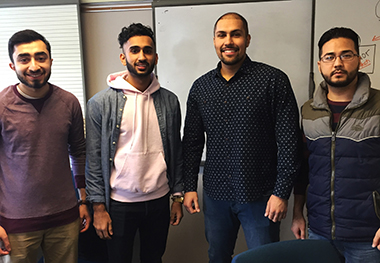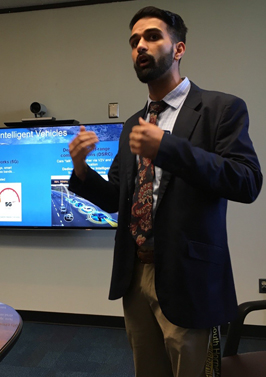Students Spring into Innovation
 |
|
The student cybersecurity team that, through the Center for Technology in Government, assessed cyber vulnerabilities of local governments, included, left to right, Saad Tai, Haseeb Kaurejo, Zabeah Ahmadzai, & Mojtaba Roshan. |
ALBANY, N.Y. (May 22, 2017) — Thirteen UAlbany students were busy balancing the usual responsibilities this semester: schoolwork, social life and jobs. But these 13 had an additional special task: helping governments prepare to use new technologies. Here is a roundup of what the 13 did this spring at the Center for Technology in Government (CTG).
Visualizing Data for a Healthier NY
Graduate Computer Science students Bhaumik Patel and Bhavik Patel, Public Administration & Policy PhD student Sora Park, and Information Science PhD student Felippe Cronemberger made health data come to life as part of CTG’s partnership with the NYS Department of Health. The project explores the potential benefits of using data visualizations to help consumers better understand health-related data already available to them. Bhaumik and Bhavik took regular charts, such as with death rates and birth statistics, and transformed them into interactive maps and graphs. As they created visualizations, Park and Cronemberger assessed their usefulness and analyzed efficiencies.
Electronic Records Management
Many small governments with limited technical capability are left with no choice but to rely on paper records and manual processes. Graduate Computer Science student Abhishek Gupta worked on CTG’s project to improve the electronic records management system currently in use by hundreds of governments throughout NYS, through a partnership with the Digital Towpath Cooperative (DTP). Gupta unraveled code and developed prototypes of improvements to the system, and was met with high praise. “We are highly impressed with Abhishek’s professionalism and attention to detail,” said DTP’s Jeanne Brown. “His work will help provide governments throughout the state with tools they haven’t had in the past.”
Cybersecurity
Even the most seemingly well-secured organizations can experience cyber-attacks when hackers gain entry through points such as a website or email system. These access points make up an “attack surface” and Information Science and Cybersecurity students Zabeah Ahmadzai, Haseeb Kaurejo, Mojtaba Roshan, and Saad Tai spent the semester learning how to perform assessments of local governments’ attack surfaces to determine vulnerabilities.
“This internship taught me the highest cybersecurity standards and helped me become a strong job candidate; I was just hired by a federal technology consulting team,” said Ahmadzai. “I look forward to leveraging my experience to help solve some of the federal government’s biggest technological challenges.”
 |
|
UAlbany MPA student Karan Verma leads a discussion on intelligent vehicles. |
The Internet of Things (IoT) for Public Transportation
CTG and the Signals & Networks Lab are studying ultra-wideband (UWB) technology, a wireless radio system that uses a small amount of energy to transmit large amounts of data. To find out if UWB lives up to its potential, Computer Science PhD students Priti Pachpande and Ahmed Hussein are conducting experiments in which UAlbany buses, shuttle stops, and the tunnel system are equipped with data transmitting sensors. The team is investigating three questions:
- Does UWB technology integrate well into existing technology systems?
- How accurate is UWB?
- Is UWB consistent and resilient?
Intelligent Vehicles & Roadways
We often hear that the IoT will revolutionize travel, such as with cars that drive for us, but many of us don’t consider what this means for the agencies overseeing our roadways. Karan Verma, an MPA student, explored “’intelligent transportation” with the NYS Thruway Authority and CTG. He set out to research topics including:
• Where is the automotive industry heading?
• What are the considerations that should be taken into account for connected/driverless vehicles?
• Do cameras have a role in traffic investigations?
Verma developed comprehensive reports and presented to Thruway Authority officials. “Karan was a pleasure to work with and his enthusiasm was inspiring,” said Kim McKinney, chief technology officer. “His research proved to be very enlightening and his presentation sparked great conversation.”
Exploring Financial Market Regulation
To maintain the financial market’s integrity, institutions are subject to requirements and restrictions, called “financial market regulation.” Andrew Roepe, a graduate student studying Public Administration and Financial Market Regulation, worked with CTG to research information sharing and integration in the context of financial market regulation. He conducted a literature review, researched current efforts to address information sharing, and contributed to a CTG report on the complexities of information sharing in this market. Sora Park, who worked on the data visualization team, was also an integral part of this work; she researched the financial regulatory environment, data sharing challenges and research questions for future studies.
Smart Cities
Matt Leger an MPA student with aspirations of holding office, is interested in how governments implement new technologies. Working with CTG, he researched the IoT, emergency management technology systems, and blockchain.
Felippe Cronemberger, who as mentioned above worked on CTG’s data visualization team, is working on his dissertation in which he is exploring the roles that information sharing and data analytics play in smart cities’ initiatives. As part of his data collection, he is studying under CTG to work with city officials to test a collaborative model for data analytics.
“Working with CTG has been valuable because I’m challenged by real-world IT problems while collaborating with an interdisciplinary team of experts,” said Cronemberger.
![]() For more news, subscribe to UAlbany's RSS headline feeds
For more news, subscribe to UAlbany's RSS headline feeds
A comprehensive public research university, the University at Albany-SUNY offers more than 120 undergraduate majors and minors and 125 master's, doctoral and graduate certificate programs. UAlbany is a leader among all New York State colleges and universities in such diverse fields as atmospheric and environmental sciences, business, education, public health,health sciences, criminal justice, emergency preparedness, engineering and applied sciences, informatics, public administration, social welfare and sociology, taught by an extensive roster of faculty experts. It also offers expanded academic and research opportunities for students through an affiliation with Albany Law School. With a curriculum enhanced by 600 study-abroad opportunities, UAlbany launches great careers.


